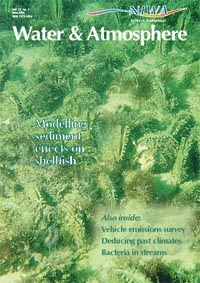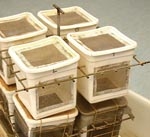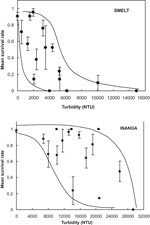PDF of this article (644 KB)

Dave Rowe Joshua Smith Erica Williams
How muddy can water be before it’s lethal to native fish? The answer is extremely muddy for most fish, but some are more sensitive than others.
When New Zealand rivers flood, they can become extremely turbid for up to several days at a time. Native fish may well be able to cope with such short spells of high turbidity. But it could be a different story in rivers where the forest cover is stripped away from the catchment and high levels of erosion occur. High rainfall and flooding will fill such rivers with more silt over longer periods. The highest turbidities seen in rivers today, especially in the slip-prone North Island east coast rivers, are probably much higher than in the past when these catchments were all forested. At a smaller, more recent scale consider what happens to native fish in small urban streams when adjacent land is cleared by bulldozers for housing. If no silt-control measures are in place, then heavy rain can dramatically increase turbidity levels.
The problem
Land-use changes at all scales in New Zealand raise the question: what are the maximum turbidity levels that can be tolerated by native fish over periods of 24 hours? In this article we describe some experiments aimed at answering the question. Our experiments had a very practical application: Auckland Regional Council (ARC) needed to know in order to set maximum permissible levels of turbidity for urban streams. Previously, NIWA has investigated the effects of sub-lethal turbidity levels on native fish, but this work did not include estimating lethal levels. We were therefore asked by the ARC to determine the lethal levels for a range of species.
The experiment


Our first task was to design tanks in which we could maintain very high turbidity levels for at least 24 hours. At the same time, we had to keep conditions such as pH, oxygen and temperature at suitable levels for fish. Finally, the fish had to be able to swim around freely.
Initial tests with conventional glass aquaria showed that turbidities up to a maximum of 10,000 NTU could be maintained for only several hours by intensive aeration. But we needed turbidities of at least 20,000 NTU for a whole day. (See panel below for an explanation of measuring turbidity.)
Such technical challenges are no match for kiwi ingenuity. We converted wheelie bins into silt re-circulation chambers by fitting water pumps and installed 12 cages per bin, each cage holding 5–10 fish. Using this apparatus we could maintain turbidities up to 38,000 NTU for over 24 hours, and also control oxygen, pH and temperature. Cage design minimised any settling of silt.
With the test apparatus refined and working well, we tested a range of fish species. Juvenile banded kokopu and adult redfinned bullies were selected because we already know that they are scarce in turbid rivers compared with clear waters. Banded kokopu in particular are known to avoid turbidities of about 20 NTU. They will even halt their upstream migration when turbidities are higher.
Smelt and inanga were also tested because they are found in the lower reaches of many Auckland streams. Smelt are also quite sensitive to a range of other environmental factors. For example, they are more sensitive than other native species to both high water temperatures and ammonia levels.
Although eels are common in Auckland streams, we did not test them because they are often found in the mud in very turbid waters and so are not considered to be sensitive to high levels of silt.
Muddy water: a problem for some fish

Surprisingly, both redfinned bullies and banded kokopu tolerated our extremely turbid waters very well. Few fish died and there were no statistical differences in death rates between fish held in clear water and those held in turbidities as high as 38,000 NTU. So the lethal level for these fish is more than 38,000 NTU. Most rivers will never be that turbid.
Both smelt and inanga were much more sensitive. Smelt was the most sensitive species: in some cages almost all fish died when held in turbidities over about 5000 NTU. Mortality rates were highly variable for both species. Our estimates of the LC50 (lethal concentration – or the turbidity producing 50% mortality over 24 hours) ranged from 1700 to 3000 NTU for smelt and 17,500 to 21,000 NTU for inanga.
The large difference in turbidity tolerances between these species reflects the range of tolerances reported for salmonid fish in the international literature. No-one has yet explained why there are such wide differences among species, although young fish appear to be more sensitive than adults, and fish undergoing physiological changes (such as smoltification – the changes associated with migration from freshwater to seawater) are also sensitive. It may be significant that smelt and inanga are both open-water, schooling fish, whereas banded kokopu and redfinned bullies are benthic (bottom-living) species. Research on the tolerances of other fish overseas indicates that most tolerate far higher levels of turbidity than smelt. Smelt are clearly one of the world’s most sensitive fish to turbidity.
The bottom line
Returning to the practical purpose of these experiments, our work showed that smelt could certainly be killed by the high turbidities produced during extreme flood events, particularly when landslides or sediment pond failures occur upstream. Ideally, maximum turbidity levels should not exceed 3000 NTU for more than 24 hours in ARC rivers and streams. In reality, oxygen concentrations and pH levels are also likely to be low during the flood conditions that produce such high turbidities. This combination of stressful factors will further increase the mortality of smelt. Under these circumstances, turbidities as low as 1500 NTU could significantly reduce their survival in the wild.
Measuring turbidity
Turbidity is a measure of the reduction in water clarity caused by suspended particles such as clay and silt. It is measured by a turbidometer, which shines a light beam through water and measures the amount of light scattering produced by suspended particles in the water sample. Turbidity is generally measured in NTU (Nephleometric Turbidity Units), and can range from 0 in clear water to over 2000 in extremely concentrated, muddy water. Slightly cloudy water has a turbidity of about 10 NTU, whereas muddy-looking water is around 20 NTU. Our ability to estimate turbidity by eye is reasonably good at low levels (i.e., less than 10 NTU), but is very limited beyond about 20 NTU.
Dave Rowe, Joshua Smith and Erica Williams are based at NIWA in Hamilton.
Teachers’ resource for NCEA AS: Biology 3.1, 3.2; Science 2.2, 2.3; Geography 1.6, 2.6, 3.6. See other curriculum connections at www.niwa.co.nz/pubs/wa/resources
Acknowledgements
This work was funded by the Auckland Regional Council and we thank Chris Hatton and John Maxted for their advice and assistance.
This experiment was conducted in accordance with NIWA’s Code of Ethical Conduct for the Use of Live Animals in Research, and was approved by NIWA’s Animal Ethics Committee.
